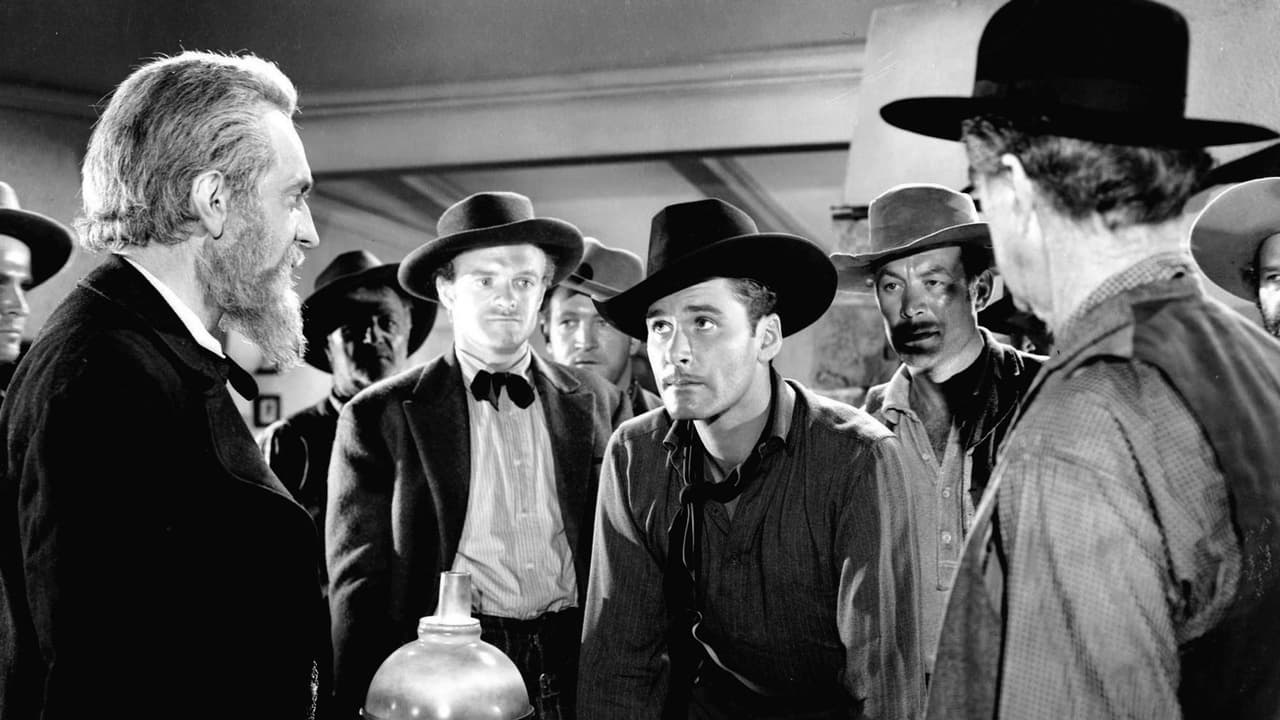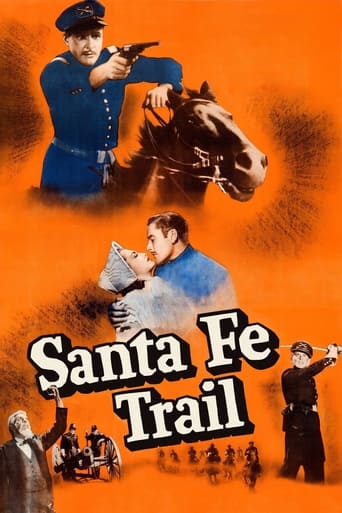

This very controversial B&W Warner film of 1940 is both an entertaining cavalry western, with several horse chases and shootouts, and an exposition of the philosophical conflicts between pro and anti-slavery proponents, that foreshadowed secession and a long bloody war between the states. As entertainment, it provides an excellent mix of action, drama, humor, mesmerizing monologues by Raymond Massey(John Brown), romance with Olivia de Havilland, and patter within and between the buddy pairs of Errol Flynn(JEB Stuart) and Ronald Reagan(Custer), and Alan Hale and 'Big Boy' Williams.Van Heflin's purely fictional obnoxious character provides an additional element of conflict as a sinister devote of Brown, who proves to have more in common with Benedict Arnold, after not receiving his expected due share of glory and monetary reward for his contributions to the cause. His vengeful role of alerting Federal troops in Washington to Brown's current raid on the Harper's Ferry arsenal has no historical relevancy. Brown's actual force was much smaller than depicted, and mostly neutralized by local militia before Federal troops arrived.As others have abundantly detailed, there are numerous historical inaccuracies in the details in the story of Brown's quest to end slavery in the US, which is what this film is essentially about. Unfortunately, this was standard fare for most Hollywood films of this era. This film has received more than it's share of criticism in this regard because of the emotional central issue of slavery and because the gist of the story is widely known. For example, I don't see damning criticism of the highly distorted contrasts between historic kings Richard and John, in "The Adventures of Robin Hood", because these distortions are not known by the American audiences and lack the emotional impact of Brown's story. Despite all the historical inaccuracies and distortions in details, I believe this film still captures the essence of the times, which is what historically-oriented films should attempt to do. This film clearly favors the view, articulated by Flynn, that slavery would have gradually disappeared from the South over time, without the necessity of southern secession or a bloody war. Clearly, this view offends many reviewers. However, without the ill-advised secession of the southern states as an unwarranted knee-jerk response to the election of Lincoln as president, this is what likely would have happened, despite the schemes of abolitionists. Savvy southern leaders, such as R.E. Lee, Jefferson Davis(both briefly included in the film), and Sam Houston, opposed secession as unwise, realizing that it failed to solve the problem of a lack of new territories for selling excess slaves, and risked widespread destruction by a stronger Union military response. Many reviewers are sarcastic about the convenient fictional West Point 'class of '54', which included a bunch of commonly recognized names in the future Civil War. Of those mentioned, only Flynn's JEB Stuart actually graduated that year. Seems like his buddy in the film should have been his Union counterpart in the war: Phil Sheridan, who graduated the year before. Presumably, the much younger Custer was chosen because of his much more widely recognized name. In any case, the short-shorn Flynn and Reagan bore no physical resemblance to the normally long-haired or well-bearded historical personages. It's Massey's fervent portrayal of Brown that makes this film most memorable. This was the role of a lifetime for him. In some scenes, Brown is portrayed as a murdering madman. In other scenes, he seems the Christ-like messiah he fancies himself to be, thus providing a basis for either view. Brown's hanging is staged as resembling Christ's crucifixion on Calvary Hill, including his Christ-like speech.. Massey often played fanatics or villains, including Lincoln, who was fanatical about making the southern states rejoin the Union, at the cost of a long bloody war. Other memorable characters he played include: the crooked salvager of sunken ship cargoes , in "Reap the Wild Wind", and the slimy villains in the Scott western "Carson City" and the musical "Desert Song".It's my contention that all 3 of Warner's Flynn-starring films released in 1940 have an intended subliminal message of presenting a strong united front against the very clear threat of a fascist-dominated Europe. This is most obvious in the Elizabethan sea war drama "The Sea Hawk", in which the Spanish clearly are presented as analogous to the Nazis in their ambition to take out England as a rival. In "Virginia City", near the end, Union and Confederate elements join together to fight off Bogart's bandidos, who want to steal the contested large gold shipment. This is followed by Flynn's eloquent Lincolnesk speech about binding the nation's wounds, after Lee's surrender. The present film features future Union and Confederate military leaders fighting together to suppress fanatical agitators who threaten to instigate a disunion of the states. Also, I strongly suspect that Brown, as characterized, is actually a metaphor for the dangerous fanatical Hitler: once a street agitator himself. As he is hanged, Lee remarks: "So perish all such foes of mankind". Going back a couple of years, we see a similar message in the replacement of Saxon-abusing acting -King John with the united ethnic policy of King Richard, in the Flynn-starring "Adventures of Robin Hood".
... View MoreRobert Buckner wrote the screenplay for this movie called " Sante Fe Trail " and was directed by Michael Curtiz. Whatever both men thought of the finish movie who can say, one thing is for sure, neither man ever made another such mess. Historically, the story is very one sided and presented John Brown (Raymond Massey) as nothing more than a raving lunatic. In addition, the title of the film is supposed to be about the Trail through the state of New Mexico. Within the scope of the story, audiences are offered a new crop of West Point cadets all of which are friends shortly before the Civil War. Errol Flynn plays Jeb Stuart. while Ronald Reagan plays George Custer and Olivia de Havilland, trying to select from the two. Far fetched as that is, the audience spends more time watching John Brown fight with the U.S. army, instead of the scenery along the trail. Were it not for the comic relief of Alan Hale or the serious addition of Van Heflin, the movie would have have garnered little more than a ho-hum. With the sounds of conflict rising and falling due to the emerging sound systems, the movie rates low as an exciting adventure story. ***
... View MoreIt's funny to see the similarities of this movie to a movie Errol Flynn made a year later. 'They Died With Their Boots On' starts out the same way, at West Point. In 'Boots', Errol Flynn plays the part of George Custer and Olivia De Havilland plays his wife. John Litel plays General Sheridan. They both have similar beginnings but tell different stories during the Civil War. Santa Fe deals with the problem of slavery, the abolitionist John Brown and in part shows how the Underground Railway helped some blacks escape slavery. It also shows the harsh reality for those who helped those blacks on the run to freedom. 'Boots' deals with the life of General George Custer, his rise through officer ranks and the dilemma he is faced with that leads to his demise at Little Big Horn. Regardless of any 'liberties' taken by the directors, both movies give an interesting incite into these historical events of the American Civil War.
... View MoreFor history buffs this must be more of a Santa Fe trial. Here is John Brown (a real historical figure played by Raymond Massey) demanding money from Boston abolitionists (also real) just before the Civil War. Give me the money, he shouts, and I'll start a slave revolution in the upland South. He knows that country. It's filled with hiding places for guerrilla warriors. So he and his handful devoted followers take over the federal arsenal and settle down in Harper's Ferry, Virginia. The tiny town was, and is, a sinkhole at the confluence of two rivers. If you stand in the main street of Harper's Ferry and look in any direction, all you see are tall wooded hills looming over you. It's about the least defensible place on the planet. There are a few African-Americans in the movie. The script has one of them say something like: "Mistuh Brown, he promised us da freedom. But if dis here Kansis is freedom, I wants to go back to Texas where Ah kin live mah lahf in PEACE." You bet.However, let us skip over the anachronisms -- the absence of muskets, the presence of generic Colt pistols, the fact that Jeb Stuart (Errol Flynn), George Armstrong Custer (Ronald Reagan), Bell, Sheridan, Longstreet, Hood, and Pickett didn't graduate from West Point in the same year -- and examine the movie as a Ding an Sich.The errors of time are lost in the headlong pace of this Western. And it IS a Western, though some scenes are set in the East. There is never any doubt who the good guys are. They're the ones who shoot their pistols jauntily, without aiming, and hit their targets. John Brown and his followers are bad guys, yes, but with mitigation, your Honor. His passion to free the slaves was all right, but his violent methods were all wrong. Every Western, though, must have a genuinely evil guy and in this case it's Van Heflin. His character seems lashed together in haste. At West Point, before he's thrown out, he reads treasonous literature to the other cadets and gets into fist fights (with Flynn!) over the issue of slavery. By the end, he's revealed as a craven money-grabber who only joined Brown's movement for the moolah, and when it's denied him he squeals on Brown to the government. That's known as discontinuity. I speak here not of historical inaccuracy but of dramatic clumsiness. God help me, my phraseology has been contaminated by listening to John Brown's dialog.You ought to see this movie if only for Raymond Massey's overblown portrait of John Brown. He never blinks. His eyes bulge -- and I swear I'm not making this up -- his eyes bulge until the dark irises are completely surrounded by white. I just tried it in the mirror and I can't even come close.There is an attempt at comedy. Its instruments are Alan Hale and Guinn "Big Boy" Williams. It fails dismally. Nothing they say or do would be funny to anyone with a sensibility quotient higher than that of a head of broccoli. The delightful Olivia de Havilland plays "Kit Carson" Halliday, the girl Flynn marries while rival Reagan stands by, shrugs good-naturedly, and smiles. The real Custer later married a smashing brunette named Libby, almost as attractive as de Havilland.It's a straightforward Warners production with Flynn, Reagan, Michael Curtiz, Max Steiner, Perc Westmore, and Sol Polito all hard at work in the factory, turning out their fast, unpretentious, actioners and dramas in their classic style.
... View More